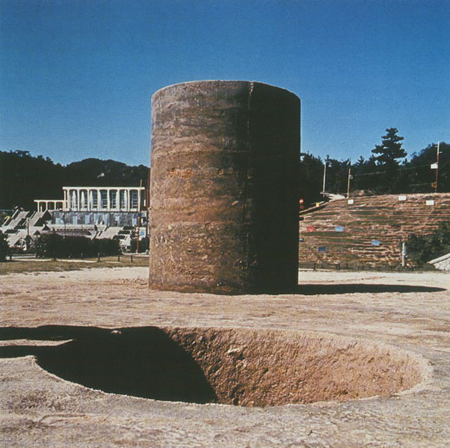Sampling Mother Earth
Nobuo Sekine
Phase — Mother Earth, 1968
(270 x 220 cm)
In October 1968 Nobuo Sekine dug a hole in the ground, shaped the extracted dirt into a large cylinder and called the work “Phase — Mother Earth.” It was probably an experiment, influenced by discussions of the new Land Art and Minimalist works taking place in the United States.
When it was first constructed, the prevailing view in Japan was that it was kind of quirky visual play of positive and negative spaces. But artist Lee Ufan disagreed, claiming that this was actually the end of visual manipulation; it was in fact a real time, real life absence and presence presented in temporal juxtaposition — a before and an after.
This, Sekine’s piece and Lee’s comment, is typically pointed to as the founding moment of Japan’s influential, homegrown Mono-ha art movement.
Born into the post-war years and the supposed ruins of consumer culture, a small group of artists were attempting to create a new, utopian reality. They proceeded as if art might be re-enchanted by shifting attention away from the objectification of images and to the creation of a world of encounters, with everyday objects, that might end up looking like mythic gestures.
Mono-ha, literally “the school of things,” was initially an informal term — sometimes used derisively — that brought together loosely affiliated artists around Tokyo including Sekine, Lee, Susumu Koshimizu, Katsuro Yoshida, and 12 or so others.
By MATT LARKING
Special to The Japan Times
“Faced with this solid block of raw earth, the power of this object of reality rendered everybody speechless, and we stood there, rooted to the spot… I just wondered at the power of the convex and concave earth, the sheer physicality of it. I could feel the passing of time’s quiet emptiness… That was the birth of ‘Mono-ha’. – Nobuo Sekine

